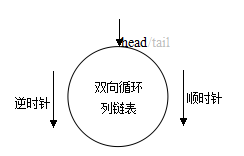Linux内核list/hlist解读
目录
1.前言
Linux内核实现了一批优雅而功能强大的双向循环列表操作宏,它们位于/usr/include/linux/list.h(请注意直接#include会报编译错误),这些宏可以直接扣出来,在需要时使用。
2.通用宏
2.1.typeof
请注意typeof并不是一个宏,而是GCC的一个内建操作符。
2.1.1.定义
typeof(variable)
2.1.2.用途
得到变量variable的类型,这个类型可以用来定义同类型的其它变量。
2.1.3.示例
int m = 1;
typeof(m) n = m; // 等同于int n = m;
2.2.offset_of
2.2.1.定义
// type:结构体类型
// member:结构体成员
#defineoffsetof(type,member)\
((size_t) &((type *)0)->member)
2.2.2.作用
计算出一个结构体type中,指定成员member在该结构体中的位置。
2.2.3.原理
(type *)0是一个类型为type的指针,其指针地址为0x0。&((type *)0)->member)是得到成员member的地址,由于结构体本身的地址为0x0,所以成员member的地址亦为member在该type中的偏移位置。
2.2.4.示例
假设有如下一个结构体:
#pragma pack(4)
struct X
{
int32_t a;
int32_t b;
int32_t c;
};
#pragma pack()
那么offsetof(Struct X, b)的值等于4。
2.3.container_of
2.3.1.定义
// ptr:结构体成员member的地址
// type:结构体类型
// member:结构体成员member
#definecontainer_of(ptr, type, member)({\
const typeof( ((type *)0)->member ) *__mptr = (ptr);\
(type *)( (char *)__mptr - offsetof(type,member) );})
2.3.2.作用
通过结构体一个成员的地址,得到该结构体的地址。
2.3.3.示例
定义结构体变量:
struct X x;
那么container_of(&x.b, struct X, b)的值将和&x相等。
2.4.prefetch
2.4.1.定义
// x:需要预读的变量
#defineprefetch(x)__builtin_prefetch(x)
2.4.2.作用
这里使用到的__builtin_prefetch是GCC内建函数,它的作用是告诉cpu括号中的x可能马上就要用到,以便cpu预取一下,这样可以提高效率。
3.list
3.1.list结构
3.1.1.定义
structlist_head
{
struct list_head *next;//指向下一个结点
struct list_head *prev;//指向前一个结点
};
这个定义虽然简单,但却是核心。
3.1.2.作用
用来实现通用的双向链表,只包括前后指针,并不包含数据成员。
3.1.3.解读
struct list_head有点类似于C++基类:
class list_head
{
public:
list_head()
: next(NULL)
, prev(NULL)
{
}
public://实际使用时,应当改为private,采用成员函数操作方式
list_head* next;
list_head* prev;
};
3.1.4.示例
在C++语言中,基类是子类实例的一个子对象。在设计模式中,有template模式与strategy两个可以相互转化的模式,template模式采用的是继承,而strategy模式采用的是子对象方式。
由于在C语言中,没有继承的概念,所以只能采用子对象的方式。因此需要这样使用:
struct MyData
{
//它在结构体中出现的顺序没有要求,
//因为可以通过下面将要介绍的container_of宏来取得它所归属结构体的地址
struct list_headlist;
char* data;
};
如果是在C++中,则:
class MyData: pubic list_head
{
private:
char* _data;
};
在C++中,如果:
list_head* data = new MyData;
则可以这样:
MyData* mydata = dynamic_cast(data);
即可由基类子对象的地址,来得到子类对象的地址。而在C语言中,则需要借助container_of宏:container_of(data, MyData, list);
3.2.遍历方向

双向循环列表头尾相连,有2个遍历方向:
1)顺时针
2)逆时针
3.3.list_entry
3.3.1.定义
// ptr:结构体成员member的地址
// type:结构体类型
// member:结构体成员member
#definelist_entry(ptr, type, member)\
container_of(ptr, type, member)
3.3.2.作用
从list_entry的定义可以看出,它等同于container_of,即通过结构体type一个成员member的地址ptr,得到该结构本的地址。
3.4.list_for_each
3.4.1.定义
// pos:指向当前结点的指针
// head:指向双向链表的头的指针
#definelist_for_each(pos, head)\
for (pos = (head)->next;\
prefetch(pos->next), pos != (head);\
pos = pos->next)
这里的prefetch(pos->next)不是必须的,只是为提升效率。
3.4.2.作用
以顺时针方向遍历双向循环链表,由于是双向循环链表,所以循环终止条件是“pos != (head)”。在遍历过程中,不能删除pos(必须保证pos->next有效),否则会造成SIGSEGV错误。
3.4.3.示例
structlist_headcur;
structlist_headlist;
list_for_each(cur, &list)
{
//使用cur
}
3.5.__list_for_each
3.5.1.定义
// pos:指向当前结点的指针
// head:指向双向链表的头的指针
#define__list_for_each(pos, head)\
for (pos = (head)->next;\
pos != (head);\
pos = pos->next)
3.5.2.作用
功能和list_for_each相同,即以顺时针方向遍历双向循环链表,只不过省去了prefetch(pos->next)。在遍历过程中,不能删除pos(必须保证pos->next有效),否则会造成SIGSEGV错误。
3.6.list_for_each_prev
3.6.1.定义
// pos:指向当前结点的指针
// head:指向双向链表的头的指针
#definelist_for_each_prev(pos, head)\
for (pos = (head)->prev;\
prefetch(pos->prev), pos != (head);\
pos = pos->prev)
3.6.2.作用
以逆时针方向遍历双向循环链表。在遍历过程中,不能删除pos(必须保证pos->prev有效),否则会造成SIGSEGV错误。
3.7.list_for_each_safe
3.7.1.定义
// pos:指向当前结点的指针
// head:指向双向链表的头的指针
// n:临时用来保存指向pos的下一个结点的指针
#definelist_for_each_safe(pos, n, head)\
for (pos = (head)->next, n = pos->next;\
pos != (head);\
pos = n, n = pos->next)
3.7.2.作用
以顺时针方向遍历双向循环链表。在遍历过程中,允许删除pos,因为每次都保存了pos->next。
3.7.3.区别
list_for_each_safe(pos, n, head)
list_for_each(pos, head)
遍历中,可删除pos
遍历中,不可删除pos
3.7.4.示例
structlist_headcur;
structlist_headtmp;//临时用来保存cur的next
structlist_headlist;
list_for_each_safe(cur, tmp, &list)
{
//使用pos
list_del(pos);//将pos从链表中剔除
delete pos;//删除pos
}
3.8.list_for_each_entry
3.8.1.定义
为方便讲解,假设有:
struct MyNode
{
struct list_head list;
};
实际中,应当将MyNode替代成需要的类型的,但不管叫什么,总是聚合了struct list_head。
// pos:指向当前结点(在这里,类型为MyNode)的指针
// head:指向双向链表list_head的头的指针
// member:list_head类型在MyNode中的成员(在这里为list)
#definelist_for_each_entry(pos, head, member) \
for (pos =list_entry((head)->next, typeof(*pos), member); \
prefetch(pos->member.next),&pos->member != (head); \
pos = list_entry(pos->member.next, typeof(*pos), member))
3.8.2.作用
以顺时针方向遍历双向循环链表。它和list_for_each一样是做链表遍历,但pos的类型不一样。在list_for_each中,pos类型是“struct list_head*”,而在list_for_each_entry是typeof(*pos)类型。
3.8.3.区别
list_for_each_entry(pos, head, member)
list_for_each(pos, head)
遍历链表,pos和head是typeof(*pos)类型
遍历链表,pos和head是struct list_head类型
3.8.4.完整示例
//这个示例,是可以编译成功,并可运行查看效果
//假设文件名为x.cpp,则编译方法为:g++ -g -o x x.cpp
#include
#include
structlist_head{
struct list_head *next, *prev;
};
static inline voidINIT_LIST_HEAD(struct list_head *list)
{
list->next = list;
list->prev = list;
}
static inline void__list_add(struct list_head *inserted,
struct list_head *prev,
struct list_head *next)
{
next->prev = inserted;
inserted->next = next;
inserted->prev = prev;
prev->next = inserted;
}
static inline voidlist_add_tail(struct list_head *inserted, struct list_head *head)
{
__list_add(inserted, head->prev, head);
}
#defineprefetch(x) __builtin_prefetch(x)
#defineoffsetof(type, member) \
((size_t) &((type *)0)->member)
#definecontainer_of(ptr, type, member) ({ \
const typeof( ((type *)0)->member ) *__mptr = (ptr); \
(type *)( (char *)__mptr - offsetof(type,member) );})
#definelist_entry(ptr, type, member) \
container_of(ptr, type, member)
#definelist_for_each(pos, head) \
for (pos = (head)->next; prefetch(pos->next), pos != (head); \
pos = pos->next)
#definelist_for_each_entry(pos, head, member) \
for (pos = list_entry((head)->next, typeof(*pos), member); \
prefetch(pos->member.next), &pos->member != (head); \
pos = list_entry(pos->member.next, typeof(*pos), member))
//以上除#include外的代码,是从/usr/include/linux/list.h直接抄过来的,
//但请注意直接#include,将无法编译通过
//定义一个结构体
struct MyData
{
public:
structlist_headlist;//功能上相当于从list_head继承
char* data;
};
int main()
{
MyData* head = new MyData;//必须有个空闲头结点
MyData* data1 = new MyData;//第一个结点
data1->data = reinterpret_cast(0x01);
MyData* data2 = new MyData;//第二个结点
data2->data = reinterpret_cast(0x02);
INIT_LIST_HEAD(&head->list);
list_add_tail(&data1->list, &head->list);
list_add_tail(&data2->list, &head->list);
//请注意cur1和cur2的数据类型
MyData* cur1 = NULL;
list_head* cur2 = NULL;
//请注意下面两个循环的区别,它们是互通的
list_for_each_entry(cur1, &head->list, list)
{
printf("%p\n", cur1->data);
}
list_for_each(cur2, &head->list)
{
MyData* dd =container_of(cur2, MyData, list);
printf("%p\n", dd->data);
}
return 0;
}
上段代码运行后,将输出以下四行信息:
0x1
0x2
0x1
0x2
3.9.list_for_each_entry_safe
3.9.1.定义
// pos:指向当前结点(在这里,类型为MyNode)的指针
// head:指向双向链表list_head的头的指针
// member:list_head类型在MyNode中的成员(在这里为list)
// n:用来临时存储pos的下一个结点(类型和pos相同)
#definelist_for_each_entry_safe(pos, n, head, member) \
for (pos = list_entry((head)->next, typeof(*pos), member),\
n = list_entry(pos->member.next, typeof(*pos), member);\
&pos->member != (head); \
pos = n, n = list_entry(n->member.next, typeof(*n), member))
3.9.2.作用
list_for_each_entry的可删除结点版本。
3.10.list_for_each_entry_reverse
3.10.1.定义
#definelist_for_each_entry_reverse(pos, head, member) \
for (pos = list_entry((head)->prev, typeof(*pos), member); \
prefetch(pos->member.prev), &pos->member != (head); \
pos = list_entry(pos->member.prev, typeof(*pos), member))
3.10.2.作用
作用和list_for_each_entry相同,只不过它是逆时针方向遍历。
3.11.list_for_each_entry_continue
3.11.1.定义
#definelist_for_each_entry_continue(pos, head, member) \
for (pos = list_entry(pos->member.next, typeof(*pos), member); \
prefetch(pos->member.next), &pos->member != (head); \
pos = list_entry(pos->member.next, typeof(*pos), member))
3.11.2.作用
以顺时针方向,从pos点开始遍历链表。
3.11.3.区别
list_for_each_entry_continue(pos, head, member)
list_for_each_entry(pos, head, member)
从pos点开始遍历链表
从头开始遍历链表
传入的pos不能为NULL,必须是已经指向链表某个结点的有效指针
对传入的pos无要求,可以为NULL
3.12.list_for_each_safe_rcu
这个牵涉到RCU(Read-Copy-Update),在这里不详细讲解了,如有兴趣,请参考《玩转多线程编程.ppt》一文。
4.hlist(hash list)
4.1.hlist(hash list)结构
4.1.1.简述
hlist也是一种双向链表,但不同于list_head,它的头部只有一个指针,常被用作哈希表的bucket数组,这样就可减少哈希bucket一半的内存消耗。

4.1.2.定义
structhlist_head{
struct hlist_node *first;
};
structhlist_node{
struct hlist_node *next, **pprev;
};





















 7881
7881











 被折叠的 条评论
为什么被折叠?
被折叠的 条评论
为什么被折叠?








